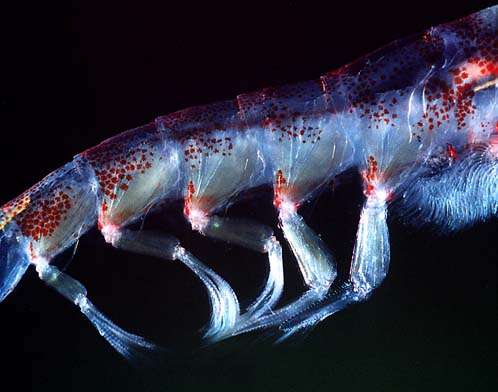September 9, 2014 report
Researchers use math and observation to show neural networks in crustaceans have evolved to offer optimized swimming

(Phys.org) —A team of researchers made up of one biologist and four mathematicians has found an example of natural selection providing an organism with optimal behavior. In their paper published in Proceedings of the National Academy of Sciences, the researchers describe how they studied the way long tailed crustaceans use their swimmerets and then developed a mathematical model to describe the most efficient way such swimmerets could be used to propel a creature—when compared, the real world method used by the crustaceans matched the optimized method found by the math models.
As the researchers note, common sense suggests that evolution causes more efficient behaviors in organisms. Body types evolve to allow land animals that chase prey to run faster, for example. But few examples exist, they point out, that actually show what is assumed to be true—that neural networks evolve to offer optimized behavior. The researchers in this latest effort sought to do just that, using a relatively simplistic creatures—long-tailed crustaceans.
Long-tailed crustaceans swim by means of little paddles called swimmerets—each moves forward in a curled position to avoid drag, then unfurls as it pushes backwards, thrusting the crayfish, prawn, lobster, etc. forward. Each of the crustaceans has several pairs of the swimmerets along its body. As it swims, the pairs move in what the team describes as a Mexican wave—where crowds at sporting events simulate a wave action. The wave action in crustaceans occurs as each pair moves a quarter-cycle behind its adjacent pair.
The researchers found that the wave action started at the back and moved to the front of the creatures, rather than the other way around, which was a surprise. To learn more, they dissected several specimens and found that the neural network consisted of two neurons controlling each swimmeret, one to cause forward motion, the other the reverse. The neuron pairs were then connected in line.
The mathematicians then went to work, composing a model to describe which of three modes of transport would be most efficient, a front-to-back wave, back-to-front wave or all swimmerets moving at the same time. They model showed that back-to-front paddling was 30 percent more efficient than simultaneous paddling and was 300 to 550 percent more efficient than front-to-back paddling. Thus, the model showed that the neural network that has evolved in long-tailed crustaceans is the optimal arrangement.
More information: Neural mechanism of optimal limb coordination in crustacean swimming , Calvin Zhang, PNAS, DOI: 10.1073/pnas.1323208111
Abstract
A fundamental challenge in neuroscience is to understand how biologically salient motor behaviors emerge from properties of the underlying neural circuits. Crayfish, krill, prawns, lobsters, and other long-tailed crustaceans swim by rhythmically moving limbs called swimmerets. Over the entire biological range of animal size and paddling frequency, movements of adjacent swimmerets maintain an approximate quarter-period phase difference with the more posterior limbs leading the cycle. We use a computational fluid dynamics model to show that this frequency-invariant stroke pattern is the most effective and mechanically efficient paddling rhythm across the full range of biologically relevant Reynolds numbers in crustacean swimming. We then show that the organization of the neural circuit underlying swimmeret coordination provides a robust mechanism for generating this stroke pattern. Specifically, the wave-like limb coordination emerges robustly from a combination of the half-center structure of the local central pattern generating circuits (CPGs) that drive the movements of each limb, the asymmetric network topology of the connections between local CPGs, and the phase response properties of the local CPGs, which we measure experimentally. Thus, the crustacean swimmeret system serves as a concrete example in which the architecture of a neural circuit leads to optimal behavior in a robust manner. Furthermore, we consider all possible connection topologies between local CPGs and show that the natural connectivity pattern generates the biomechanically optimal stroke pattern most robustly. Given the high metabolic cost of crustacean swimming, our results suggest that natural selection has pushed the swimmeret neural circuit toward a connection topology that produces optimal behavior.
Journal information: Proceedings of the National Academy of Sciences
© 2014 Phys.org


















